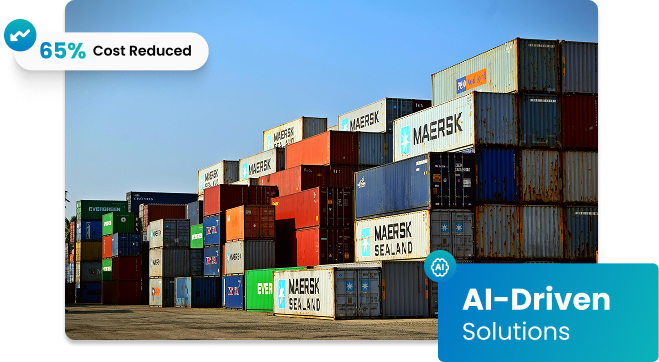Build Smarter, Stronger, More Resilient Supply Chains
Turning Supply Chain Challenges Into Strategic Opportunities
When supply chains break, your entire business feels it. Cannsult helps you keep things moving with supply chain consulting tailored to your industry’s unique demands. We focus on streamlining operations, cutting costs, managing risks, and building the flexibility to adapt quickly. Whether you're solving today’s bottlenecks or preparing for tomorrow’s disruptions, we help you design supply chains that are resilient, efficient, and built for long-term success.

Why Businesses Trust Cannsult
At Cannsult, we deliver more than just consulting – we offer solutions that are specifically tailored to meet your unique challenges and opportunities.
Smarter Networks, Faster Flow
From sourcing to delivery, we help you reduce waste, improve visibility, and strengthen your supply chain at every link.
End-to-End Supply Chain Assessments
We conduct deep-dive audits of your entire supply chain to identify bottlenecks, risks, and cost-saving opportunities.
Supply Chain Strategy and Design
We build agile, resilient supply chain strategies that align with your growth plans, industry pace, and customer expectations.
Supplier Relationship Management
We help you strengthen supplier partnerships, improve contract performance, and mitigate sourcing risks.
Inventory Management Optimization
We design inventory strategies that reduce holding costs, improve turnover, and increase fulfillment speed.
Logistics and Distribution Improvement
We streamline transportation, warehousing, and last-mile delivery for faster, more reliable operations.
Industry-Specific Supply Chain Solutions
We tailor supply chain strategies for healthcare, manufacturing, retail, technology, finance, education, and more.
From Chain Reactions to Chain Resilience
Our structured, hands-on process helps you transform your supply chain from a cost center to a competitive advantage.
How We Turn Supply Chains Into Profit Engines
94%
Average Cut in Logistics Costs
500+
Successful Supply Chain Projects Completed
35%
Faster Order Fulfillment After Redesign
3x
Faster Response to Supply Disruptions
60%
Increase in Inventory Turnover Rates
20+
Countries Served with Localized Expertise
30%
Less Waste from Lean Inventory Models
98%
Satisfaction Rate in Supply Chain Engagements

Supply Chain Bottlenecks Slowing You Down?
Case Studies
Discover the real-world success stories where we’ve helped businesses achieve transformative results.
Cadence Health
40%
Decrease in calls about health benefits
30%
Reduction in admission and discharge wait times
Hilton Hotels
70%
Reduction in video latency (from 5 seconds to 1.5 seconds).
50%
Improvement in transcoding time and better audio-video synchronization (under 1 second).
Givaudan Fragrances
20%
Reduction in production cycle times, saving $110K and cutting complaints.
30%
Reduction in rush orders and expired inventory through streamlined quality control.
Kaiser Permanente
65%
Drop in pharmacy requisition errors, cutting costs.
85%
Increase in radiology film availability, enhancing diagnostics.
30%
Increase in product adoption from app integration.
25%
Reduction in duplicate records, improving data efficiency.
HealthQuest
100%
Removal of unnecessary post-PCI transfers, easing resources.
20%
Increase in bed placement efficiency, cutting wait times.
75%
Claims reported within 24 hours, up from 43%.
40%
Drop in complaints about premiums, cancellations, and denials.
43%
Drop in monthly escalated issues, from over 7,000 to under 4,000.
30%
Faster IT project cycle times, speeding execution and delivery.
CD Media
220%
Increase in website traffic, with 175% more reader engagement.
100%
Increase in content output to 4x/day at 400 words each.
Clinical Psychology
25%
Improvement in diagnostic accuracy, enhancing treatment precision.
40%
Rise in referrals and add-on services, expanding the client base.
30%
Growth in membership, especially in joint, partnership, and sponsorship categories.
22%
Rise in silent auction revenue with better promotion.
Givaudan Flavors
60%
Yield increase, reducing distillation time from 65 to 24 hours
100%
Inventory accuracy, cutting data defects to 5%.
What Our Clients Say
See how our expert solutions have helped businesses and individuals achieve lasting success.
(5.0)
Delivering Results with a Simple, Focused Lean Approach!
I enjoyed working with you on many improvement projects using the Lean approach.
Your lead in keeping focused, making it simple and fun was natural. That got engagement from all in the project teams and delivered results in a timely manner.

Nigel Beeby
Process Engineer at MM Kembla
(5.0)
Cannsult Doesn’t Just Consult—They Transform!
Riaan and Cannsult have been a phenomenal asset for our company. We have engaged them for several key initiatives and they have taken the opportunity to learn our entire business and help rebuild our processes from the ground up. Riaan and team have worked very hard and went above and beyond their scope of duties to deliver truly fantastic results. We are very thankful to be working together with Cannsult.

Nicholas Kovacevich
Entrepreneur and Executive
(5.0)
Riaan’s Passion for Transformation is Truly Inspiring!
I met Riaan on a learning mission to Japan to study the Toyota Production System via the Honsha consulting group. I found Riaan to be a gregarious leader who was the perfect fit to lead a culture transformation. He has a deep understanding the philosophy and the tools of TPS. He has the passion for continuous improvement, but best of all he has the personality to provide confidence and a sense of humor to lead people to want to transform. Everyone enjoys being around Riaan.

Kyle Stavig
CEO @ North Coast Container
(5.0)
Riaan's Passion for Growth, Leadership, and Lean Excellence!
Riaan has proven his desire to learn and apply Lean. I had the privilege to spend a week with Riaan in Japan as part of the Honsha Japan Executive Development Mission. Riaan demonstrated the humility necessary to learn and contributed to the group with his key insights. It was a pleasure to spend time with him.

Darril Wilburn
Sr. Partner at Honsha.ORG
Your Supply Chain Questions—Answered
We help you understand how Cannsult’s supply chain consulting delivers speed, savings, and long-term stability.
What is supply chain consulting?
It’s the process of analyzing, improving, and future-proofing supply chains to increase efficiency, reduce costs, and minimize risks.
How does Cannsult approach supply chain transformation?
We conduct end-to-end assessments, redesign networks, and build scalable supply chain strategies that fit your industry and growth goals.
Which industries do you support with supply chain consulting?
We offer supply chain solutions for healthcare, manufacturing, retail, technology, financial services, education, and more.
What makes Cannsult’s supply chain services different?
How do we start working with Cannsult?
Book a free consultation. We’ll assess your current supply chain and design a roadmap to help you scale smarter and move faster.
Ready to start your project?
Stay updated with the latest trends, insights, and case studies from our experts.

We would love to discuss your new business challenge.
Fill the form or send us an email to info@cannsult.org
Let's talk to find a solution in less than 24 hours.


